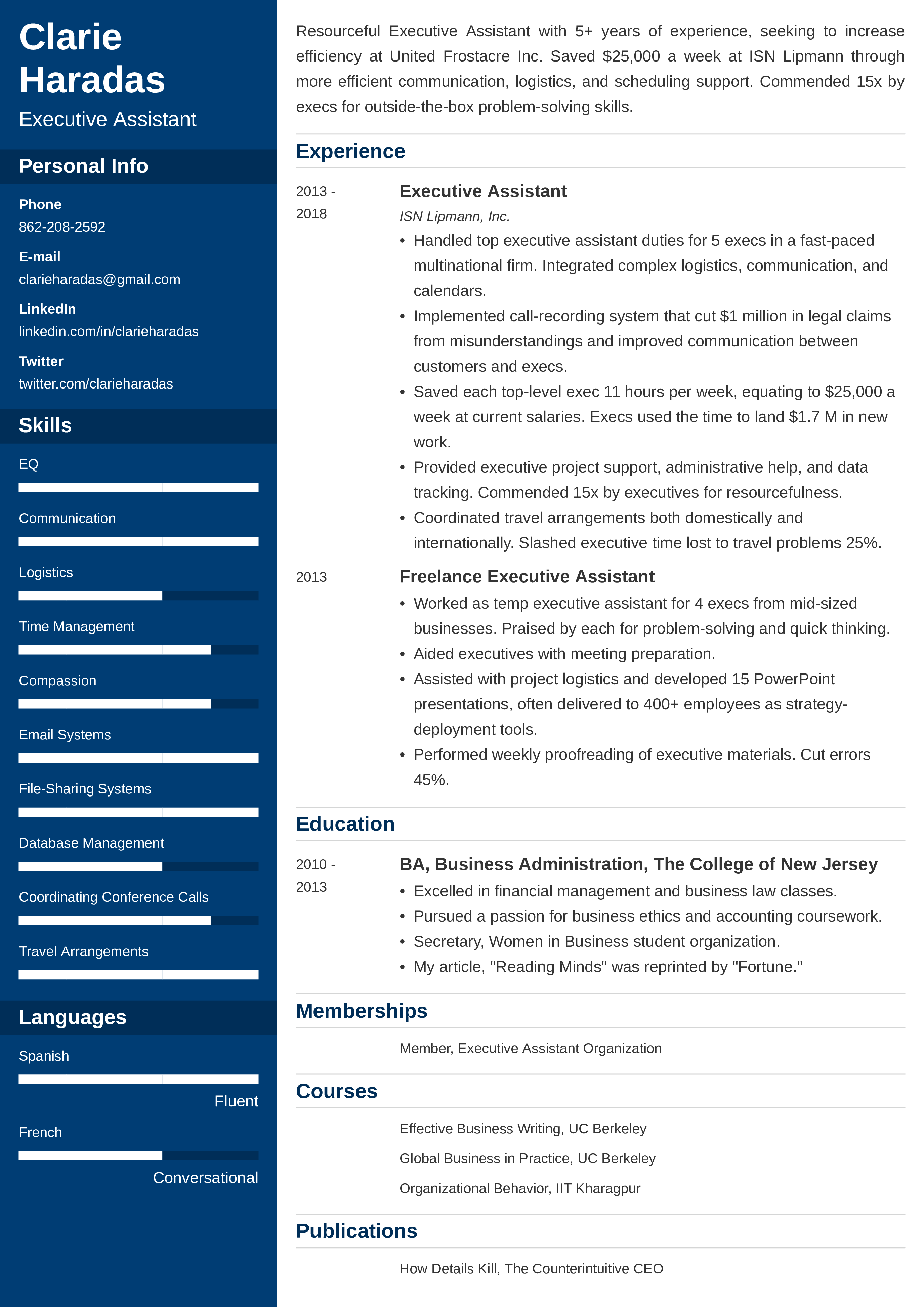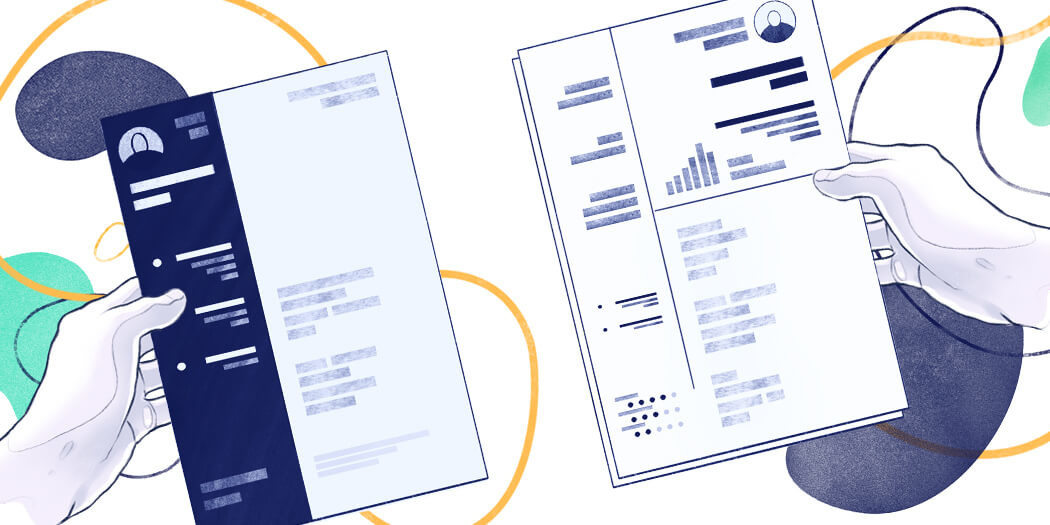
Write the Perfect Resume in 9 Simple Steps (With Examples)
Sometimes, a good resume isn’t enough. Find out how to make a perfect resume that proves you’re the best candidate for the job.

Olga Ber
Career Expert
All good resumes share a vital feature. They have the right resume sections. In the correct order. With the right contents. And you really need to get all these things right, not to get left behind.
In this guide, I’ll show you the following:
Save hours of work and get a job-winning resume like this. Try our resume builder with 20+ resume templates and create your resume now.

What users say about ResumeLab:
I had an interview yesterday and the first thing they said on the phone was: “Wow! I love your resume.”
Patrick
I love the variety of templates. Good job guys, keep up the good work!
Dylan
My previous resume was really weak and I used to spend hours adjusting it in Word. Now, I can introduce any changes within minutes. Absolutely wonderful!
George
If you’re looking for specific info, here’s a table of contents you can use to help you navigate through this article:
A single glance at a resume should be enough for the recruiter to know whether they’re dealing with an entry-level candidate or a seasoned pro. You can show it by including the right sections on your resume in the right order.
The 5 key sections of a resume are:
It doesn't matter if you're applying for a job in the US or if you're using the Canadian resume format.
Let me tell you more about each one in more detail:
If your contact information isn’t there, you can just as well submit a blank page—it will amount to just as much.
Lucky for you, this section of a resume is pretty straightforward. The only information you need to put in here is:
Putting your address on a resume is unnecessary, although you may sometimes want to include it. You may also want to consider including your LinkedIn handle in the contact information section. Just make sure it’s up-to-date.
Some things you should never include in this resume section are your race, gender, and your photo. You don’t want to have any information that could lead to having your resume discarded due to discrimination, as half of employers still judge candidates based on appearance.
The only exception is if you’re applying for an appearance-based job, such as an actor, or if you’re writing a biodata for a job.
Nicole Zuniga
UX Designer
Phone: 501-872-2516
Email: nicole.zuniga@gmail.com
linkedin.com/in/nicolezuniga
Nicole Zuniga
Date of Birth: 07.11.1987
Gender: Female
Marital Status: Married
Phone: 501-872-2516
Your resume profile is either your professional summary or your resume objective. Choose the former if you already have a couple of years of experience, and the latter when you’re just starting your career.
Fortunately, both of them follow pretty much the same rules. When writing this resume section, remember to:
The main difference between these two types of resume sections is that a resume summary focuses on work achievements, while a resume objective should mention academic wins and extracurricular experiences.
See these examples:
Passionate UX Designer with 6+ years of experience. Seeking to use proven wireframing and prototyping skills to improve Z-Factor’s Apps profitability. At ArcLight, raised average subscription conversion by 21% in 1 year by optimizing the user experience journey. Trained 6 new employees in UX design and created a proprietary A/B testing system, cutting testing costs by 9%.
Passionate, hard-working, go-getting UX Designer, looking for a new position. Highly skilled in visual design, computer graphics, and training. Recently worked at ArcLight as a UX designer specializing in app optimization. Highly proficient with prototyping and A/B testing.
As I mentioned before, this resume section needs to neatly and succinctly highlight your work experience and impressive achievements. Just like a book review, it needs to make the recruiter want to read more. That’s also why numbers are so powerful here.
Now, a resume objective:
Final year General Engineering student at the University of South Carolina with a projected 3.75 GPA and consistent Dean’s List recognition. Leader of the most successful Engineering Society team, winning 3 out of the last 4 challenges. Practical experience from internships at P&D and SpaceQ, working with mechanical engineers on 3D design and printing, laying a strong foundation for a career at DNP.
I am nearing graduation with a degree in General Engineering from the University of South Carolina. I have a strong interest in CAD and CNC design, and during my two internships, I focused primarily on 3D design and printing. I am now seeking my first engineering position.
The thing is, that second candidate might not be bad, they just can’t showcase their strengths as well as the first example. Oh, and a piece of advice from me, avoid using the first-person pronouns on your resume. It’s an outdated practice.
This is the central section of a resume. Recruiters will usually look at this one right after going through your resume profile. That means you must build your experience resume section correctly. To write a good job experience section, follow these steps:
And when you’re listing out your job experience, use a chronological resume format. This way, whenever a recruiter reads this resume section, they will always see your most recent experience first.
What does it mean to present your work experience as achievements rather than responsibilities? It means you should always say what you did rather than what you were expected to do.
To visualize what it looks like, check out these examples:
User Experience Architect
ArcLight, New York
April 2019–Present
ArcLight, New York, April 2019–Present
User Experience Architect
Expert Hint: Remember that no recruiter wants to read huge paragraphs of text, especially in this section of a resume. Organize your experience into short and strong resume bullet points to maximize their effectiveness.
Just like when you list out your job experience, you’ll want to segregate your resume education section with your most recent, highest degree at the top. If you have a university degree, mark just that. Going back to high school is unnecessary.
Each entry in your resume education section should include the following information:
If you’re starting out, it may be wise to put some effort into this area. It’s a great place to list any potential extracurricular activities, relevant coursework, publications, etc. If your work experience section isn’t too impressive, this part of a resume is where you can shine!
See the examples:
University of South Carolina, Columbia, SC
Bachelor of Science in General Engineering
August 2018 – May 2022
Relevant Coursework:
Projects:
University of South Carolina, Columbia, SC
Bachelor of Science in General Engineering
August 2018 – May 2022
GPA: 3.35
The first sample of this resume section is as good as a couple of years of work experience. On the other hand, the second doesn’t show anything and makes a mistake of mentioning GPA, when it’s under 3.5.
The skills section on a resume may appear insignificant, but it’s vital. Job listings always have many skills in them, whether hidden in their description or sitting in plain sight under “job requirements.” We call them resume keywords. And the skills resume section is the best place to show the recruiter that you have all the qualities they are looking for!
Sometimes you may come across resume templates that separate the skills section into two separate skill categories for a resume. While you should include a mix of hard and soft skills on your resume, don’t split them into separate sections. It’s a common mistake in which people want to put at least ten skills in each skills' category on their resume, going above the recommended resume length. The best way to create a skills resume section is to list them as short bullet points. Also, try to include 8-10 skills total in this section.
So, your skills resume section should look something like that:
Skills
Those were the top 5 key sections of your resume. Now, I’ll tell you about bonus sections.
The ResumeLab builder is more than looks. Get specific content to boost your chances of getting the job. Add job descriptions, bullet points, and skills. Easy. Improve your resume in our resume builder now.

Nail it all with a splash of color, choose a clean font, and highlight your skills in just a few clicks. You're the perfect candidate, and we'll prove it. Use our resume builder now.
Before adding additional sections, ensure they enrich your resume rather than dilute its value. For example, if the job listing says fluency in French and German is beneficial, add a languages section and show your expertise if you know them. Similarly, if you know neither of these languages, omit this resume section and don’t mention it.
So, what popular resume sections can you use? Let’s briefly go through some of them.
Additional languages on a resume can be very beneficial. Even if the job offer doesn’t specifically list any languages, employers often look positively at applicants who know multiple languages. So don’t hesitate to show your language abilities.
Here’s what this resume section may look like:
Expert Hint: Remember always to provide a level of proficiency. There is a huge difference between being able to hold a conversation and working using a specific language.
This section is more tricky than it seems. The hobbies and interests on a resume can say a lot about you, and they may also corroborate your previously mentioned skills. If you mentioned in your resume that you’re a very patient person, you could confirm it here by listing painting as one of your hobbies.
But don’t mention any irrelevant or controversial hobbies. And if you’re not sure what hobbies you could include, see our article on good hobbies and interests for a resume.
In practically every working field, there are certifications to be earned. These can show in which areas you’re exceptionally proficient and showcase the scope of your knowledge. Having recognizable certifications on a resume can significantly boost your chances of getting a job.
Awards are a bit less common, and they can be anything from “Employee of the Month”, up to military service honors. So, only include these resume sections if your certifications and awards apply to the job you’re pursuing.
Expert Hint: Not every course ends with a certificate. If you attended some courses like that and want to show it, create a ‘Courses’ resume section.
Publications on a resume are a great way to show your expert knowledge. Not everyone can boast that they have any articles published, which means you’ll really stand out from the crowd if you do! But remember not to go overboard with them. Instead, list only a couple of the most relevant and prominent ones.
When it comes to formatting, follow this template for magazines and web-based publications:
[“Publication Title”], [Where it Was Published], [Month and Year]
Books are a bit more complicated than that, use an APA format or an MLP one.
Maybe you’re an active member of an organization with a history of expertise in the industry. If so, why not highlight it in a membership resume section? You should format your memberships in this way:
[Organization Name], [Your Title in the Organization]
And under that, list some relevant achievements and contributions. For these, follow the same style as when writing your work experience section.
American Society of Mechanical Engineers (ASME), Member
Engineers Without Borders (EWB), Volunteer Engineer
References on a resume are a unique section. Do you know how on LinkedIn, you can write references under someone’s profile? This works the same on a resume. If an industry expert vouches for you and agrees to you putting their name and email address on a resume, go for it. Some names will get you instant recognition. Use the following format if you decide to include references.
[Reference’s First & Last Name]
[Their Professional Title]
[Name of Their Company]
[Company Street Address]
[Company City, State & Zip Code]
[Reference’s Work Phone Number]
[Reference’s Work Email Address]
Volunteer work on a resume is especially beneficial for employees with little to no experience. It can show your hard work, dedication, and compassion. And most importantly of all, even if you didn’t work for money, you still worked. And work is experience. Some of which can be very relevant and wow the recruiter. For the volunteering resume section, use the same format as you did with the work experience resume category.
Riverton Soccer League, Volunteer Soccer Coach
Volunteer Soccer Coach
The art of public speaking is a rare one. Add to that the knowledge that’s expert enough for you to be a speaker at a conference, and you have yourself a fantastic achievement. To write a conference resume section, use a layout similar to publications:
[“Presentation Title”], [Event Name], [City], [Month and Year]
Treat this as an “everything else” section. When putting extracurricular activities on a resume, you should first decide whether they are relevant enough. Then, depending on the activities, either write them as a bullet list or, if you have some specific achievement to show, use the tried and tested work experience format. This section can include sports clubs, student organization memberships, abroad studies, or fundraisers.
And since that was a lot to remember, here’s a handy infographic to make it a bit more digestible:

When writing a resume, you most likely fall under one of three categories, each slightly impacting the way you should order your resume sections:
With these three cases in mind, let’s see how you should order your resume. Let’s start with the standard resume outline for someone with a couple of years of experience already.
There are two primary things to consider in this case. The first one is the use of a professional summary. The second is the placement of the experience section on the resume. Why are these important? Let’s look at the structure of an entry-level resume to compare.
Do you see the differences? This time, the professional summary has changed into a career objective, and the education section is put before the experience section. So, why is that the case?
It’s simple: when you don’t have any experience or your experience is minimal and barely relevant, you need to show the recruiter something else that you have. And that thing is usually your education. Of course, if you have relevant experience, you should showcase it in every resume format.
And what about the career objective? That also has a lot to do with your lack of experience. Although it’s in the same place on a resume as a professional summary, so the order doesn’t change, it should be written differently, with another goal in mind.
Also, I recommend adding a hobbies and interests section right after your skills for inexperienced resumes. This allows you to confirm your skills by showing the recruiter your relevant passions. As a more experienced employee, you might want to add different resume sections there, such as publications, or received awards.
The thing with changing a career is that you may have had a lot of experience, but most of it could be irrelevant to the position you’re currently pursuing. And you need to adapt to it by slightly altering the professional resume format.
That’s why you should opt for the professional objective (rather than the summary) and follow it up with your relevant experience. This way, you’ll show the recruiter your motivation and back it up with examples. Also, you may consider including an additional experience resume section where you can put things indirectly related to the job you want to get.
And just like in the previous cases, let relevance guide your choice of what additional resume sections to include.
Expert Hint: Changing careers can be stressful—I’ve been there myself. That’s why we have a great guide specifically for writing a resume for a career change.
Double your impact with a matching resume and cover letter combo. Use our cover letter generator and make your application documents pop out.

Want to try a different look? There's 21 more. A single click will give your document a total makeover. Pick a cover letter template here.
The most important sections of a resume you need to include are:
There are also a lot of optional sections you can pull from to enhance your resume even further. These include certifications, known languages, publications, interests, and more.
Do you have any questions? Would you like to share your observations on resume sections and their order? I’d love to hear from you! Please give me a shout-out in the comments below.

Sometimes, a good resume isn’t enough. Find out how to make a perfect resume that proves you’re the best candidate for the job.

Olga Ber
Career Expert

Job hunting can be confusing. You know you need a resume, but what is it exactly, and how to even write one? Deep breaths. Read on to learn everything you need to know.

Michael Tomaszewski, CPRW
Certified Professional Resume Writer, Career Expert

What should be the margins on a resume? How to set them right? Well, you don’t have to worry anymore. We’ve got your answers & some cool text alignment tips.

Maciej Duszynski, CPRW
Certified Professional Resume Writer, Career Expert